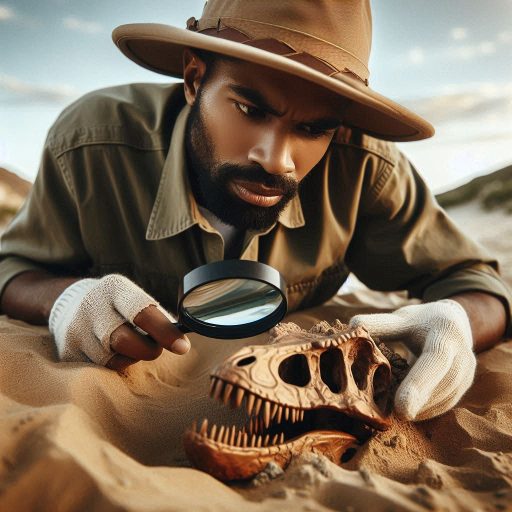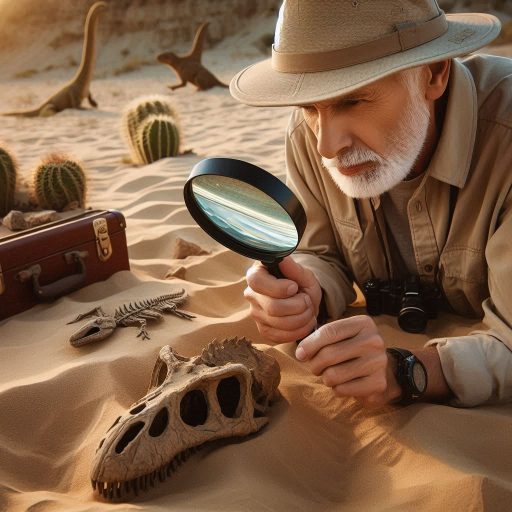Introduction
Paleontological research involves studying fossils to uncover insights into Earth’s ancient life and ecosystems.
This field seeks to understand the relationships between extinct organisms and their environments, offering a window into the planet’s evolutionary history.
By analyzing fossil records, paleontologists can reconstruct past environments, track evolutionary changes, and comprehend how life responded to various environmental shifts.
Fossils provide critical evidence about Earth’s biological and geological history, helping scientists piece together the timeline of life over millions of years.
Studying fossils is essential for understanding patterns of extinction, adaptation, and biodiversity throughout Earth’s history.
These insights not only inform our understanding of past life forms but also serve as valuable lessons for present-day conservation efforts.
By learning how ancient species adapted to their environments, scientists can better predict how current ecosystems might respond to ongoing changes.
However, climate change is now significantly influencing paleontological research.
Rising global temperatures and shifting environmental conditions are affecting fossil sites, altering the preservation of newly discovered specimens.
Extreme weather events, such as flooding and erosion, can damage valuable fossil deposits, limiting access to critical data.
Furthermore, climate change is shifting research priorities, as scientists increasingly focus on understanding how ancient species responded to past climate events.
The impact of changing climates on fossil preservation
How Rising Temperatures Can Affect Fossil Degradation
Rising temperatures significantly impact fossil degradation.
Increased heat can accelerate the chemical reactions that break down organic materials.
As temperatures rise, fossils may become more brittle and prone to damage.
This degradation poses a challenge for paleontologists studying ancient life forms.
Preservation of delicate specimens becomes increasingly difficult in warmer climates.
Moreover, higher temperatures can lead to increased erosion.
Erosion exposes fossils to the elements, making them vulnerable to further degradation.
As climate change progresses, paleontologists must adapt their preservation techniques.
They may need to implement more rigorous measures to protect vulnerable fossil sites.
This situation emphasizes the urgency of addressing climate change’s impact on paleontological research.
How Changes in Precipitation Patterns Can Impact Fossil Formation
Changes in precipitation patterns also affect fossil formation.
Climate change can lead to more intense and erratic rainfall, impacting sediment deposition.
Fossilization typically occurs in stable sedimentary environments.
Disrupted sediment layers make it harder for fossils to form properly.
Heavy rainfall can wash away sediment layers that contain fossils.
This erosion can destroy critical evidence of ancient ecosystems.
Conversely, prolonged droughts can lead to reduced sediment supply.
In arid regions, lower water levels hinder fossil preservation by limiting burial in sediment.
Use Examples of Specific Fossil Sites That Have Been Impacted by Climate Change
Several fossil sites illustrate the impact of climate change on paleontological research.
One notable example is the Burgess Shale in Canada.
This site contains exceptionally well-preserved Cambrian fossils.
However, climate change poses a threat to the site’s geological stability.
Increased temperatures and precipitation changes can affect its unique preservation conditions.
Another example is the La Brea Tar Pits in Los Angeles.
The site contains fossils of Ice Age animals trapped in tar.
Climate change affects the tar’s viscosity and the surrounding environment.
Changes in temperature and precipitation patterns may alter how fossils are preserved and excavated.
The fossil beds of the Green River Formation in Wyoming also face challenges from climate change.
This site is known for its exceptional fossil fish and plant remains.
As precipitation patterns shift, the sedimentation processes that contribute to fossil formation may be disrupted.
Researchers worry about the future of this important paleontological resource.
Basically, climate change profoundly influences paleontological research.
Rising temperatures increase fossil degradation and erosion, threatening valuable specimens.
Changes in precipitation patterns disrupt fossil formation and preservation.
Specific fossil sites like the Burgess Shale and La Brea Tar Pits exemplify these challenges.
As paleontologists confront these issues, they must adapt their methods and approaches.
Addressing climate change is essential for safeguarding our understanding of Earth’s history.
Shifts in biodiversity due to changing climates
How Climate Change Can Lead to the Extinction of Certain Species
Climate change significantly impacts ecosystems and can lead to the extinction of various species.
Rising temperatures alter habitats, making them unsuitable for certain organisms.
As temperatures increase, many species struggle to adapt or find suitable environments.
This stress can result in population declines and eventual extinction.
Additionally, changing climate patterns affect food availability.
For example, some plants may not survive in warmer conditions, impacting herbivores that rely on them.
If herbivore populations decline, predators that depend on these animals also face challenges.
This cascading effect can lead to the extinction of multiple interconnected species.
Human activities further exacerbate climate change, leading to habitat destruction.
Urbanization, deforestation, and pollution disrupt ecosystems and accelerate species loss.
As environments change rapidly, some species cannot keep pace, resulting in irreversible biodiversity loss.
How New Environments Are Being Created Due to Climate Change, Leading to the Discovery of Previously Unknown Fossils
Climate change creates new environments, often altering landscapes dramatically.
Melting glaciers reveal previously buried land and fossils, exposing ancient ecosystems to researchers.
As permafrost thaws, it uncovers well-preserved specimens that provide insights into past climates and organisms.
Rising sea levels also create new coastal environments, which can lead to fossil discoveries.
Erosion exposes layers of sediment that hold previously unknown fossils.
These new finds can reshape our understanding of ancient biodiversity and evolutionary processes.
Shifting ecosystems allow paleontologists to study how species adapt or evolve in response to environmental changes.
By examining these new environments, scientists gain valuable information about ancient life and its interactions with climate.
Implications of These Biodiversity Shifts on Paleontological Research
The biodiversity shifts caused by climate change have significant implications for paleontological research.
First, they change the distribution of fossil sites.
As species migrate to new areas, their fossilized remains may be found in unexpected locations.
This shift challenges researchers to adapt their search strategies and fieldwork methodologies.
Moreover, understanding current biodiversity loss informs our interpretations of past extinction events.
Researchers can draw parallels between today’s rapid changes and historical events.
By studying these patterns, paleontologists can gain insights into how climate change influences extinction dynamics.
The emergence of new fossil sites allows for the exploration of novel evolutionary adaptations.
Researchers can investigate how species responded to past climate shifts, offering valuable lessons for today’s biodiversity crisis.
These findings may help predict which species are most vulnerable to current climate challenges.
Additionally, increased access to previously unexplored areas can lead to a richer understanding of prehistoric ecosystems.
This new data enhances our knowledge of life on Earth and how it has evolved over millions of years.
Therefore, climate change profoundly influences paleontological research.
It leads to species extinction, creates new environments, and reshapes biodiversity.
Understanding these dynamics is essential for researchers aiming to connect past and present ecological shifts.
By studying these changes, paleontologists can inform conservation efforts and enhance our understanding of life on Earth.
Read: The Role of Chemists in US Environmental and Sustainability Efforts
Changes in research methodologies
How Researchers Are Adapting Their Methods to Account for Changing Climates
Climate change significantly impacts paleontological research.
As temperatures rise, researchers adjust their methods to study fossils effectively.
They now prioritize locations that may preserve evidence of past climates.
This includes investigating sedimentary layers in areas affected by recent climate changes.
Researchers also employ interdisciplinary approaches, combining paleontology with climate science to analyze fossil data more comprehensively.
Fieldwork strategies have evolved as well.
Scientists are increasingly using remote sensing technologies to map fossil sites.
This approach reduces the time spent on-site and allows researchers to gather data from larger areas.
Additionally, they often collaborate with climate scientists to model potential future climate scenarios.
These models help researchers understand how past ecosystems responded to climate shifts.
New Technologies That Are Being Used to Study Fossils in the Context of Climate Change
New technologies have transformed how researchers study fossils in relation to climate change.
One significant advancement is the use of 3D imaging and modeling.
This technology allows scientists to create detailed reconstructions of fossilized organisms.
It also helps analyze morphological changes over time in response to environmental shifts.
Furthermore, researchers utilize isotopic analysis to gain insights into ancient climates.
By examining the isotopic composition of fossilized remains, scientists can reconstruct temperature and precipitation patterns.
This data provides crucial context for understanding how past ecosystems adapted to climate changes.
Advanced data analysis tools, such as machine learning algorithms, are also emerging.
These tools can process vast amounts of paleontological data quickly.
They help researchers identify patterns and correlations between fossil records and climatic conditions.
By harnessing these technologies, paleontologists can better understand the impact of climate change on ancient life.
Challenges Faced by Paleontologists in Conducting Research in Rapidly Changing Environments
Paleontologists face numerous challenges in conducting research amid rapid climate change.
One significant challenge is the degradation of fossil sites.
Erosion and other climate-related factors can destroy valuable evidence of past life.
As habitats change, researchers may find it increasingly difficult to locate well-preserved fossils.
Additionally, the urgency of climate change demands quick adaptation.
Researchers must continuously update their methods to keep pace with changing conditions.
This need for rapid adaptation can strain resources and funding.
Many paleontologists rely on grants and institutional support, which may not always be readily available.
Collaboration is essential but can also pose challenges.
Working across disciplines requires effective communication and understanding of different methodologies.
Scientists must navigate varying priorities and perspectives, which can complicate research efforts.
In review, climate change significantly influences paleontological research methods.
Researchers adapt by prioritizing specific locations and employing interdisciplinary approaches.
New technologies, such as 3D imaging and isotopic analysis, enhance the study of fossils.
However, challenges like site degradation and funding constraints hinder research efforts.
As paleontologists continue to confront these challenges, their work remains vital for understanding the long-term effects of climate change on life on Earth.
Read: Day in the Life: An Environmental Scientist’s Typical Day
Paleoclimate reconstruction and its importance
Explain How Paleontologists Use Fossil Records to Reconstruct Past Climates
Paleontologists play a crucial role in understanding climate change through fossil records.
They study ancient organisms preserved in sedimentary rock layers.
These fossils provide valuable information about past environmental conditions.
By analyzing the physical characteristics of fossils, paleontologists infer climatic conditions during the time these organisms lived.
Isotope analysis is a common technique used to gather climate data from fossils.
For example, oxygen isotopes in marine fossils can indicate past ocean temperatures.
Similarly, plant fossils can reveal information about prehistoric vegetation types, which reflect climatic conditions.
By combining data from various fossils, paleontologists can reconstruct ancient ecosystems and the climates that supported them.
This process enables researchers to create comprehensive models of Earth’s climate history.
Significance of Understanding Past Climate Patterns for Predicting Future Climate Change
Understanding past climate patterns is vital for predicting future climate change.
Climate change is not a new phenomenon; it has occurred throughout Earth’s history.
By studying how ecosystems responded to previous climate changes, scientists can better anticipate future impacts.
For instance, past events like the Permian-Triassic extinction can provide insight into how life on Earth adapts to rapid climate shifts.
Paleontological data also help in recognizing natural climate variability.
This knowledge allows scientists to distinguish between human-induced changes and natural cycles.
Understanding the feedback mechanisms between climate and ecosystems enhances the accuracy of current climate models.
These models are essential for policymakers as they plan for potential climate impacts.
Examples of How Paleoclimate Reconstructions Have Contributed to Climate Change Research
Paleoclimate reconstructions have made significant contributions to climate change research.
One notable example is the study of ice cores from Greenland and Antarctica.
Scientists analyze trapped air bubbles in ice cores to gauge past atmospheric composition and temperature.
This data reveals historical climate fluctuations and enhances understanding of current trends.
Another example includes the analysis of tree rings, known as dendrochronology.
Tree rings provide annual records of climate conditions.
Researchers can determine periods of drought, temperature extremes, and other climate-related events.
This data helps scientists understand how ecosystems have changed over time in response to climate variations.
Additionally, studies of marine sediments have uncovered insights into oceanic climate changes.
Researchers examine foraminifera, tiny marine organisms, to infer past sea temperatures and ice cover.
This information helps scientists understand ocean circulation patterns and their influence on global climates.
Generally, paleontologists use fossil records to reconstruct past climates, significantly enhancing climate change research.
Understanding these patterns is essential for predicting future climate changes and informing effective policies.
By examining fossils, ice cores, tree rings, and marine sediments, researchers gain valuable insights into Earth’s climate history.
These contributions play a vital role in addressing the challenges posed by current and future climate change.
Read: The Impact of Technology on the Chemist Profession in the US

Implications for conservation and policy
How Paleontological Research Can Inform Conservation Efforts in the Face of Climate Change
Paleontological research plays a vital role in informing conservation efforts amid climate change.
By studying ancient ecosystems, paleontologists reveal how species responded to past climate shifts.
This understanding helps predict how current species might react to ongoing changes.
Paleontologists can identify patterns of resilience and vulnerability in various species.
These insights guide conservationists in developing targeted strategies to protect threatened habitats and species.
For example, studies of past extinction events provide valuable lessons on biodiversity loss.
Paleontologists examine the factors that contributed to these extinctions, such as habitat destruction and climate fluctuations.
By analyzing fossil records, they identify which species were most vulnerable.
Conservationists can then prioritize the protection of these vulnerable species and their habitats.
This proactive approach ensures that conservation strategies are based on scientific evidence and historical context.
How Policymakers Can Use Paleontological Findings to Make More Informed Decisions About Climate Change Mitigation Strategies
Policymakers can utilize paleontological findings to shape climate change mitigation strategies effectively.
Understanding the long-term impacts of climate change on ecosystems aids in developing informed policies.
Paleontologists provide essential data on how ecosystems have historically adapted to climate changes.
This information helps policymakers identify potential pathways for adaptation and resilience.
Additionally, paleontological research highlights the importance of preserving biodiversity.
Policymakers can use this information to create regulations that protect critical habitats.
By promoting policies that support conservation, they can ensure ecosystems remain resilient to climate change.
Integrating paleontological insights into climate action plans fosters a more comprehensive approach to mitigation strategies.
Moreover, collaboration between paleontologists and environmental scientists can enhance policy development.
By working together, these experts can provide a holistic view of climate change impacts.
This collaboration leads to more effective conservation strategies that consider both historical and current data.
Transform Your Career Today
Unlock a personalized career strategy that drives real results. Get tailored advice and a roadmap designed just for you.
Start NowThe Role of Paleontologists in Advocating for Climate Action Based on Their Research
Paleontologists play a crucial role in advocating for climate action based on their research.
They communicate their findings to the public, policymakers, and the scientific community.
By sharing insights from ancient climates, paleontologists emphasize the urgency of addressing climate change.
Their research often reveals the long-term consequences of environmental neglect, fostering a sense of responsibility.
Paleontologists participate in public forums and scientific conferences to raise awareness.
They highlight the need for immediate action to preserve biodiversity and ecosystem health.
By educating others on the historical context of climate change, they encourage a proactive approach to conservation.
Furthermore, paleontologists can collaborate with advocacy groups to influence policy decisions.
Their expertise provides valuable evidence in discussions about climate action and conservation initiatives.
By engaging with stakeholders, paleontologists can help shape policies that reflect scientific knowledge and urgency.
In general, paleontological research is essential for informing conservation efforts in the face of climate change.
Policymakers can utilize these findings to make informed decisions and develop effective strategies.
The role of paleontologists in advocating for climate action underscores the importance of integrating science into public discourse.
Their work contributes to a more sustainable future for our planet and its inhabitants.
Read: US Chemistry Conferences and Symposiums to Attend in 2024
Collaborations between paleontologists and climate scientists
Importance of Interdisciplinary Collaborations in Studying the Impacts of Climate Change on Paleontology
Interdisciplinary collaborations are vital in studying climate change impacts on paleontology.
Climate change is a multifaceted issue, affecting various scientific disciplines.
Paleontology, which focuses on the study of ancient life through fossils, can greatly benefit from insights gained in other fields.
By working together, scientists can develop a more comprehensive understanding of how climate change influences both past and present ecosystems.
Collaborating across disciplines encourages the sharing of methodologies and data.
Paleontologists can utilize climate models and geological data provided by climate scientists.
This integration allows for a more nuanced analysis of fossil records, revealing how ancient organisms adapted to climate changes.
Such insights can inform current conservation efforts and predict how species might respond to future climate shifts.
How Paleontologists and Climate Scientists Are Working Together to Understand the Complex Interactions Between Climate Change and Fossil Records
Paleontologists and climate scientists are increasingly collaborating to study the complex interactions between climate change and fossil records.
They examine how past climate fluctuations influenced species diversity and extinction events.
By analyzing fossil records, scientists can identify patterns of adaptation or extinction related to historical climate changes.
Recent research projects have focused on specific time periods, such as the Paleocene-Eocene Thermal Maximum.
This era experienced rapid warming, leading to significant shifts in biodiversity.
By studying fossil evidence from this period, researchers can better understand the mechanisms behind species resilience or vulnerability.
Field studies often involve both paleontologists and climate scientists collecting data.
Paleontologists provide expertise in fossil excavation and identification, while climate scientists contribute climate data and modeling.
Together, they create a more detailed picture of how ecosystems responded to climatic shifts in the past.
Benefits of Bringing Together Different Expertise
Bringing together different areas of expertise yields numerous benefits in addressing climate change challenges in paleontological research.
First, interdisciplinary collaboration fosters innovative approaches to complex problems.
By combining knowledge from various fields, researchers can develop new hypotheses and methodologies that address climate change effects on fossils and ecosystems.
Collaborative projects also enhance funding opportunities.
Funding agencies often prioritize interdisciplinary research that tackles pressing global issues, such as climate change.
By presenting a unified research agenda, paleontologists and climate scientists can secure necessary resources to conduct impactful studies.
Moreover, interdisciplinary collaborations facilitate knowledge exchange.
Researchers can learn from each other’s techniques and approaches, broadening their understanding of climate change and its implications.
This exchange enriches the scientific community and leads to more robust and comprehensive research findings.
Finally, combining expertise from various fields increases the visibility of paleontological research.
By collaborating with climate scientists, paleontologists can highlight the relevance of their work in understanding current climate challenges.
This visibility can attract public interest and support for both paleontological research and climate action initiatives.
In essence, interdisciplinary collaborations are essential for studying climate change impacts on paleontology.
By working together, paleontologists and climate scientists can unravel complex interactions between climate and fossil records.
This collaborative approach offers numerous benefits, advancing research and fostering a deeper understanding of how climate change influences life on Earth.
Conclusion
In this blog, we explored how climate change significantly influences paleontological research.
We examined how shifting climates affect fossil preservation and the accessibility of excavation sites, which can hinder scientists’ ability to study critical periods in Earth’s history.
These changes pose considerable challenges for researchers studying ancient ecosystems and biodiversity, as they must adapt to new realities in the field.
Understanding the historical impacts of climate change on past life forms provides valuable insights for future predictions.
By analyzing how ancient species responded to climatic shifts, scientists can better comprehend how current species might react to ongoing environmental changes.
This knowledge is essential for developing effective conservation strategies to safeguard biodiversity in a rapidly changing world.
I encourage researchers to further investigate the relationship between climate change and paleontological studies.
Collaborative efforts among scientists, ecologists, and climatologists can lead to a comprehensive understanding of these challenges.
Interdisciplinary research will enable a more holistic approach to studying the effects of climate change, ensuring that paleontological findings inform contemporary environmental policies.
[E-Books for Sale]
The Big Book of 500 High-Paying Jobs in America: Unlock Your Earning Potential
$19.99 • 500 High-Paying Jobs • 330 pages
Explore 500 high-paying jobs in America and learn how to boost your career, earn more, and achieve success!
See All 500 High-Paying Jobs of this E-Book
1001 Professions Without a Degree: High-Paying American Jobs You Can Start Now
$19.99 • 1001 Professions Without a Degree • 174 pages
Discover 1001 high-paying jobs without a degree! Unlock career tips, skills, and success strategies for just $19.99!




